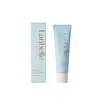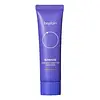What's inside
What's inside
 Key Ingredients
Key Ingredients

 Benefits
Benefits

 Concerns
Concerns

 Ingredients Side-by-side
Ingredients Side-by-side

Water
Skin ConditioningZinc Oxide
Cosmetic ColorantDibutyl Adipate
EmollientPanthenol
Skin ConditioningIsoamyl Laurate
EmollientButyloctyl Salicylate
Skin ConditioningDicaprylyl Ether
EmollientNiacinamide
SmoothingPolyglyceryl-6 Polyhydroxystearate
EmulsifyingPolyglyceryl-6 Polyricinoleate
EmulsifyingSilica
AbrasivePolyglyceryl-4 Oleate
EmulsifyingDisteardimonium Hectorite
StabilisingCaprylyl Methicone
Skin ConditioningMagnesium Sulfate
Trimethylsiloxysilicate
EmollientPrunus Persica Flower Extract
MoisturisingNicotinoyl Dipeptide-23
Skin ConditioningGlyceryl Glucoside
HumectantHyaluronic Acid
HumectantHydrolyzed Hyaluronic Acid
HumectantSodium Hyaluronate
HumectantMadecassoside
AntioxidantEucommia Ulmoides Bark Extract
AntioxidantCentella Asiatica Extract
CleansingLupinus Albus Seed Oil
Skin ConditioningAscorbyl Palmitate
AntioxidantGlycerin
HumectantDecyl Glucoside
CleansingHelianthus Annuus Seed Oil
EmollientCalamine
AbsorbentLauryl Polyglyceryl-3 Polydimethylsiloxyethyl Dimethicone
Skin ConditioningPolyhydroxystearic Acid
EmulsifyingPolyglycerin-6
HumectantSodium Benzoate
MaskingTocopherol
AntioxidantPotassium Sorbate
PreservativeAdenosine
Skin ConditioningTriticum Vulgare Germ Oil Unsaponifiables
EmollientCaprylyl Glycol
Emollient1,2-Hexanediol
Skin ConditioningPentylene Glycol
Skin ConditioningTrisodium Ethylenediamine Disuccinate
Citrus Paradisi Peel Oil
MaskingCI 77491
Cosmetic ColorantCI 77492
Cosmetic ColorantLimonene
PerfumingWater, Zinc Oxide, Dibutyl Adipate, Panthenol, Isoamyl Laurate, Butyloctyl Salicylate, Dicaprylyl Ether, Niacinamide, Polyglyceryl-6 Polyhydroxystearate, Polyglyceryl-6 Polyricinoleate, Silica, Polyglyceryl-4 Oleate, Disteardimonium Hectorite, Caprylyl Methicone, Magnesium Sulfate, Trimethylsiloxysilicate, Prunus Persica Flower Extract, Nicotinoyl Dipeptide-23, Glyceryl Glucoside, Hyaluronic Acid, Hydrolyzed Hyaluronic Acid, Sodium Hyaluronate, Madecassoside, Eucommia Ulmoides Bark Extract, Centella Asiatica Extract, Lupinus Albus Seed Oil, Ascorbyl Palmitate, Glycerin, Decyl Glucoside, Helianthus Annuus Seed Oil, Calamine, Lauryl Polyglyceryl-3 Polydimethylsiloxyethyl Dimethicone, Polyhydroxystearic Acid, Polyglycerin-6, Sodium Benzoate, Tocopherol, Potassium Sorbate, Adenosine, Triticum Vulgare Germ Oil Unsaponifiables, Caprylyl Glycol, 1,2-Hexanediol, Pentylene Glycol, Trisodium Ethylenediamine Disuccinate, Citrus Paradisi Peel Oil, CI 77491, CI 77492, Limonene
Water
Skin ConditioningEthylhexyl Triazone
UV AbsorberDibutyl Adipate
EmollientPropanediol
SolventDiethylamino Hydroxybenzoyl Hexyl Benzoate
UV FilterButyloctyl Salicylate
Skin ConditioningNiacinamide
SmoothingBis-Ethylhexyloxyphenol Methoxyphenyl Triazine
Skin ConditioningCI 77891
Cosmetic ColorantCoco-Caprylate/Caprate
Emollient1,2-Hexanediol
Skin ConditioningPolyglyceryl-3 Methylglucose Distearate
EmulsifyingCI 77007
Cosmetic ColorantTromethamine
BufferingDaucus Carota Sativa Root Extract
Skin ConditioningSilica
AbrasiveCarbomer
Emulsion StabilisingAmmonium Acryloyldimethyltaurate/Vp Copolymer
Acrylates/C10-30 Alkyl Acrylate Crosspolymer
Emulsion StabilisingPolyacrylate Crosspolymer-6
Emulsion StabilisingVp/Eicosene Copolymer
Stearyl Alcohol
EmollientCetyl Alcohol
EmollientEthylhexylglycerin
Skin ConditioningPolyglyceryl-6 Polyhydroxystearate
EmulsifyingPolyglyceryl-6 Polyricinoleate
EmulsifyingAluminum Hydroxide
EmollientKaolin
AbrasiveAllantoin
Skin ConditioningTriethoxycaprylylsilane
Adenosine
Skin ConditioningSodium Stearoyl Glutamate
CleansingPolyglycerin-6
HumectantSaccharide Hydrolysate
HumectantBetaine
HumectantCamellia Sinensis Leaf Water
MaskingT-Butyl Alcohol
PerfumingMyristyl Alcohol
EmollientLauryl Alcohol
EmollientTocopherol
AntioxidantAscorbyl Palmitate
AntioxidantWater, Ethylhexyl Triazone, Dibutyl Adipate, Propanediol, Diethylamino Hydroxybenzoyl Hexyl Benzoate, Butyloctyl Salicylate, Niacinamide, Bis-Ethylhexyloxyphenol Methoxyphenyl Triazine, CI 77891, Coco-Caprylate/Caprate, 1,2-Hexanediol, Polyglyceryl-3 Methylglucose Distearate, CI 77007, Tromethamine, Daucus Carota Sativa Root Extract, Silica, Carbomer, Ammonium Acryloyldimethyltaurate/Vp Copolymer, Acrylates/C10-30 Alkyl Acrylate Crosspolymer, Polyacrylate Crosspolymer-6, Vp/Eicosene Copolymer, Stearyl Alcohol, Cetyl Alcohol, Ethylhexylglycerin, Polyglyceryl-6 Polyhydroxystearate, Polyglyceryl-6 Polyricinoleate, Aluminum Hydroxide, Kaolin, Allantoin, Triethoxycaprylylsilane, Adenosine, Sodium Stearoyl Glutamate, Polyglycerin-6, Saccharide Hydrolysate, Betaine, Camellia Sinensis Leaf Water, T-Butyl Alcohol, Myristyl Alcohol, Lauryl Alcohol, Tocopherol, Ascorbyl Palmitate
Ingredients Explained
These ingredients are found in both products.
Ingredients higher up in an ingredient list are typically present in a larger amount.
1,2-Hexanediol is a synthetic liquid and another multi-functional powerhouse.
It is a:
- Humectant, drawing moisture into the skin
- Emollient, helping to soften skin
- Solvent, dispersing and stabilizing formulas
- Preservative booster, enhancing the antimicrobial activity of other preservatives
Adenosine is in every living organism. It is one of four components in nucleic acids that helps store our DNA.
Adenosine has many benefits when used. These benefits include hydrating the skin, smoothing skin, and reducing wrinkles. Once applied, adenosine increases collagen production. It also helps with improving firmness and tissue repair.
Studies have found adenosine may also help with wound healing.
In skincare products, Adenosine is usually derived from yeast.
Learn more about AdenosineAscorbyl Palmitate is created by combining pure Vitamin C and palmitic acid. It is an antioxidant and helps reduce hyperpigmentation.
This ingredient is a more stable version of Vitamin C, meaning it does not disintegrate as quickly when exposed to sunlight. However, studies show it does not penetrate skin as well as pure Vitamin C.
Ascorbyl Palmitate is oil soluble.
Read more about other types of Vitamin C:
Learn more about Ascorbyl PalmitateButyloctyl Salicylate is a chemical UV filter structurally similar to octisalate. It is a photostabilizer, SPF booster, emollient and solvent. This ingredient helps evenly spread out ingredients.
According to a manufacturer, it is suitable for pairing with micro Titanium Dioxide, Zinc Oxide, and pigments.
Photostabilizers help stabilize UV-filters and prevents them from degrading quickly.
Learn more about Butyloctyl SalicylateDibutyl Adipate is an emollient and solvent. It is created from butyl alcohol and adipic acid.
As a solvent, Dibutyl Adipate helps mix and disperse ingredients evenly.
Dibutyl Adipate is soluble in water and organic solvents. It does not absorb UV rays.
Learn more about Dibutyl AdipateNiacinamide is a multitasking form of vitamin B3 that strengthens the skin barrier, reduces pores and dark spots, regulates oil, and improves signs of aging.
And the best part? It's gentle and well-tolerated by most skin types, including sensitive and reactive skin.
You might have heard of "niacin flush", or the reddening of skin that causes itchiness. Niacinamide has not been found to cause this.
In very rare cases, some individuals may not be able to tolerate niacinamide at all or experience an allergic reaction to it.
If you are experiencing flaking, irritation, and dryness with this ingredient, be sure to double check all your products as this ingredient can be found in all categories of skincare.
When incorporating niacinamide into your routine, look out for concentration amounts. Typically, 5% niacinamide provides benefits such as fading dark spots. However, if you have sensitive skin, it is better to begin with a smaller concentration.
When you apply niacinamide to your skin, your body converts it into nicotinamide adenine dinucleotide (NAD). NAD is an essential coenzyme that is already found in your cells as "fuel" and powers countless biological processes.
In your skin, NAD helps repair cell damage, produce new healthy cells, support collagen production, strengthen the skin barrier, and fight environmental stressors (like UV and pollution).
Our natural NAD levels start to decline with age, leading to slower skin repair, visible aging, and a weaker skin barrier. By providing your skin niacinamide, you're recharging your skin's NAD levels. This leads to stronger, healthier, and younger looking skin.
Another name for vitamin B3 is nicotinamide. This vitamin is water-soluble and our bodies don't store it. We obtain Vitamin B3 from either food or skincare. Meat, fish, wheat, yeast, and leafy greens contain vitamin B3.
The type of niacinamide used in skincare is synthetically created.
Learn more about NiacinamideWe don't have a description for Polyglycerin-6 yet.
Polyglyceryl-6 Polyhydroxystearate isn't fungal acne safe.
Polyglyceryl-6 Polyricinoleate isn't fungal acne safe.
Silica, also known as silicon dioxide, is a naturally occurring mineral. It is used as a fine, spherical, and porous powder in cosmetics.
Though it has exfoliant properties, the function of silica varies depending on the product.
The unique structure of silica enhances the spreadability and adds smoothness, making it a great texture enhancer.
It is also used as an active carrier, emulsifier, and mattifier due to its ability to absorb excess oil.
In some products, tiny microneedles called spicules are made from silica or hydrolyzed sponge. When you rub them in, they lightly polish away dead skin layers and enhance the penetration of active ingredients.
Learn more about SilicaTocopherol (also known as Vitamin E) is a common antioxidant used to help protect the skin from free-radicals and strengthen the skin barrier. It's also fat soluble - this means our skin is great at absorbing it.
Vitamin E also helps keep your natural skin lipids healthy. Your lipid skin barrier naturally consists of lipids, ceramides, and fatty acids. Vitamin E offers extra protection for your skin’s lipid barrier, keeping your skin healthy and nourished.
Another benefit is a bit of UV protection. Vitamin E helps reduce the damage caused by UVB rays. (It should not replace your sunscreen). Combining it with Vitamin C can decrease sunburned cells and hyperpigmentation after UV exposure.
You might have noticed Vitamin E + C often paired together. This is because it is great at stabilizing Vitamin C. Using the two together helps increase the effectiveness of both ingredients.
There are often claims that Vitamin E can reduce/prevent scarring, but these claims haven't been confirmed by scientific research.
Learn more about TocopherolWater. It's the most common cosmetic ingredient of all. You'll usually see it at the top of ingredient lists, meaning that it makes up the largest part of the product.
So why is it so popular? Water most often acts as a solvent - this means that it helps dissolve other ingredients into the formulation.
You'll also recognize water as that liquid we all need to stay alive. If you see this, drink a glass of water. Stay hydrated!
Learn more about Water